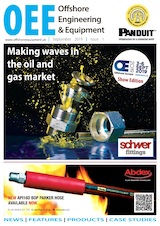Maximising economic recovery
Published: 08 December, 2015
The launch of a new service focused on assets at late life stage and those nearing cessation of production has been announced by Lloyd's Register Energy. The new service will assist operators with maximising economic recovery and reducing costs by eliminating inspection and maintenance activities that don’t fulfill safety or profit objectives. ODEE report.
In a marketplace of tighter margins, identifying where best to concentrate inspection, maintenance and other core operational activities is a critical success factor for operators. This requires the use of techniques to assess and manage the ageing situation such as adopting risk profiling strategies to gain a clearer understanding of equipment reliability, inspection programmes and the economic influences affecting production.
“Thanks to successful Asset Life Extension (ALE) studies and the application of asset management methodologies along with advances in technology, assets and fields have successfully produced well beyond their original design life”, says Ken Bruce, SVP Asset Integrity Services, Lloyd’s Register Energy. “But there comes a time when operators must consider the viability and profitability of their assets as they move from extended production to late life and Cessation of Production.”
Bruce highlighted: “The oil and gas industry, as a whole, is trying to delay premature decommissioning in order to maximise the economic recovery of the UKCS as there are still production gains to be realised from many of these assets at the late stage of the lifecycle.”
Oil and gas companies are faced with the challenge of having assets in their portfolios that are operating at various stages of their life-cycle, requiring each asset to be managed on an individual basis.
And, in a marketplace of tighter margins, identifying where best to concentrate inspection, maintenance and other core operational activities is a critical success factor for operators.
Operators are relentlessly focusing on safety, environment and life-of-field asset stewardship – a key move in the face of spiraling costs and aging platforms and infrastructure. Many operators across Europe have been reported to have had several assets described as being at the “challenging end of the scale” in terms of decommissioning liabilities. They have to find innovative and creative ways to become a safe yet ultra-low cost operator. There will be a very strong focus on cost delivery, as well as selected, but limited, investment to maximise economic resource recovery.
“Across the world, ageing infrastructure used in oil and gas operations needs to achieve a drastic reduction in costs to remain profitable. Most operators are still resourced for fields operating at peak capacity and have been unable to drive costs down in line with decreasing production, due to outdated operating models. We can help operators safely reduce costs by eliminating unnecessary inspection and maintenance activities, identifying a new level of acceptable risk and realigning operating models,” said Bruce.
The challenge of operating aging assets is impacting the industry in regions including the North Sea, Irish Sea and the Gulf of Mexico. But the oil and gas industry is not alone in experiencing these challenges. Today mature operating assets make up 70% of the world’s energy production and include nuclear, chemical, and petrochemical infrastructure.
Bridging the gap between late-life operations and Cessation of Production, Lloyd’s Register Energy experts say they can provide detailed insight for an operator on their inspection, corrosion, technical safety, and materials engineering issues. This expertise can be applied across the energy mix and across any asset providing a truly global solution to the challenges of how best to manage and operate ageing infrastructure.
Lloyd’s Register Energy is already engaged with operators who deem this new capability an attractive proposition given the current cost-conscious climate in oil and gas.
About the new ‘late-life’ service
The new ‘late-life’ integrity management service optimises asset safety, integrity and life-cycle costs through the complete asset life-cycle and is accredited to ISO 9001:2008 and ISO / IEC 17020 standards. It meets HSE’s requirements, and provides in-depth assessment and a systematic approach in:
• Facilities life extension studies;
• Integrity efficiency improvement and reliability / availability analysis;
• Bespoke fitness for service assessments;
• Obsolescence management;
• safety critical elements and performance standards review;
• Identification of critical assets and equipment
• Asset audits and reviews: performance improvement, environmental, integrity management and technical safety;
• Development and implementation of late-life operation strategies including preservation procedures.
For further information please visit: www.lr.org





